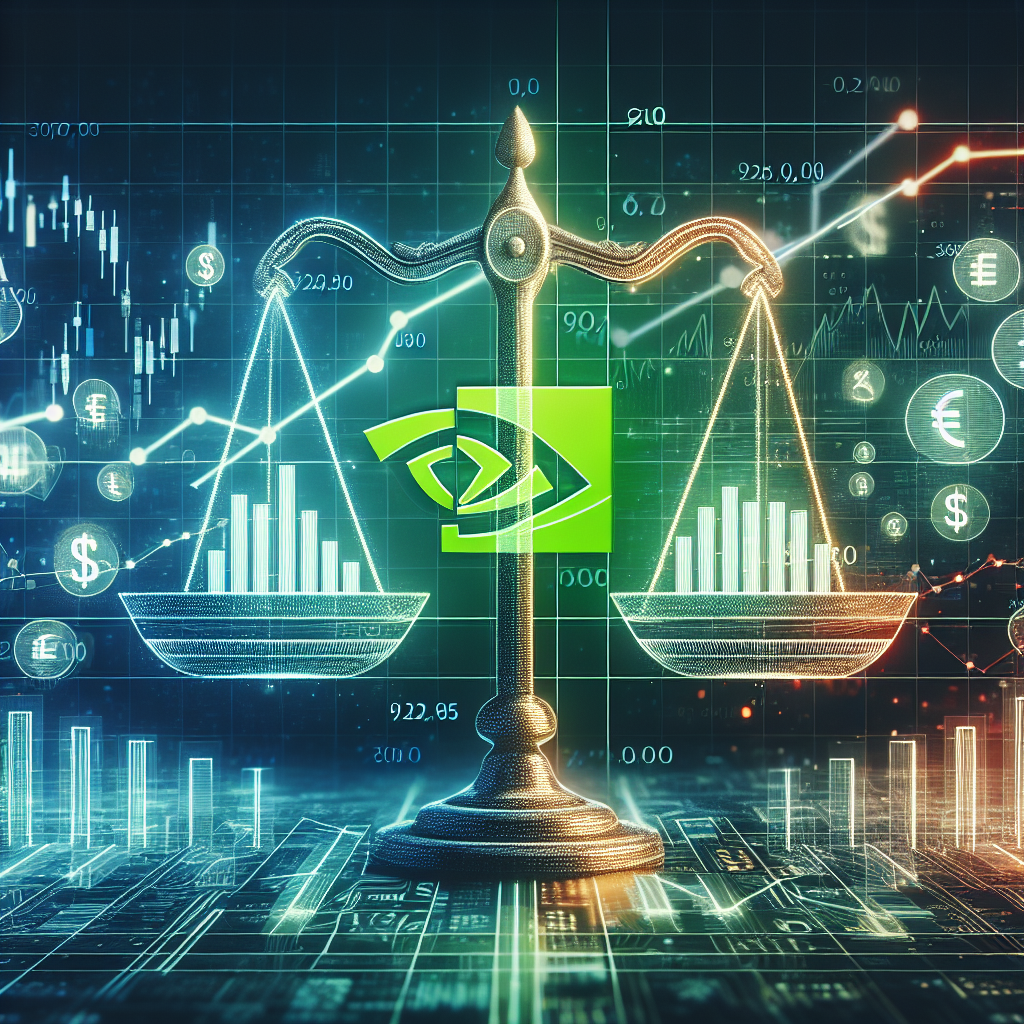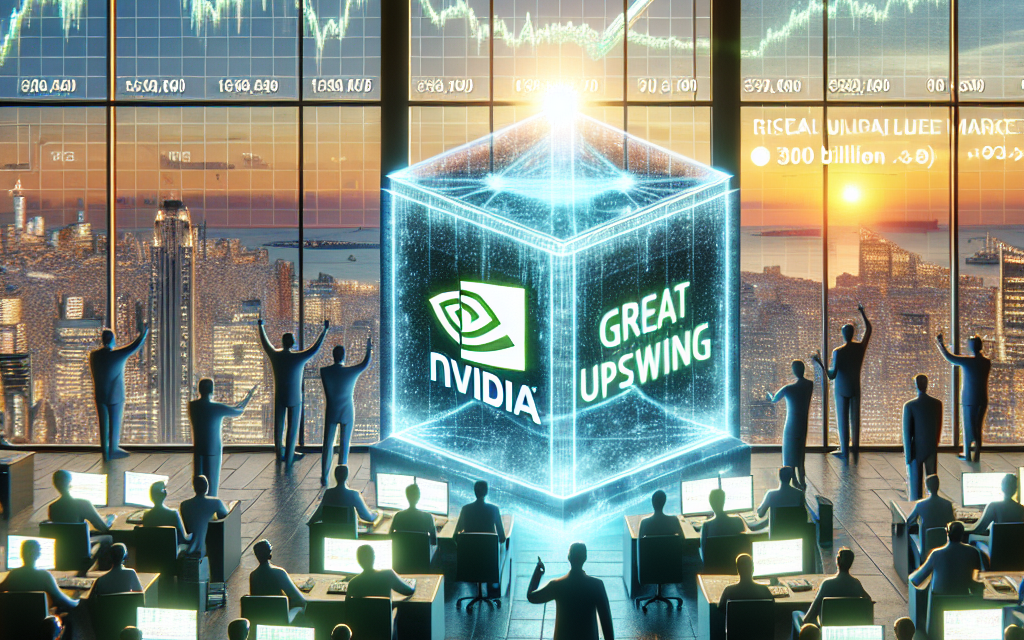“Powering the Future: Nvidia’s Strategic Leap into the $300 Billion Market Revolution”
Introduction
Nvidia, a leading player in the semiconductor industry, is strategically positioned to capitalize on a significant $300 billion market shift following its recent earnings report. The company’s robust performance and innovative advancements in artificial intelligence, data centers, and gaming have set the stage for substantial growth opportunities. As Nvidia continues to expand its influence across various sectors, its options for leveraging this market shift are poised to redefine industry standards and drive future success. With a focus on cutting-edge technology and strategic partnerships, Nvidia is well-equipped to navigate the evolving landscape and maintain its competitive edge in the global market.
Impact Of Nvidia’s Earnings On The Semiconductor Industry
Nvidia’s recent earnings report has sent ripples through the semiconductor industry, marking a potential $300 billion market shift that could redefine the landscape for years to come. As a leading player in the semiconductor sector, Nvidia’s performance and strategic decisions are closely watched by investors, competitors, and industry analysts alike. The company’s latest financial results have not only exceeded expectations but have also set the stage for significant changes across the industry.
To begin with, Nvidia’s robust earnings underscore the growing demand for its advanced graphics processing units (GPUs), which are pivotal in powering artificial intelligence (AI) applications, gaming, and data centers. The company’s ability to consistently innovate and deliver high-performance products has solidified its position as a market leader. This success is reflected in the substantial increase in its stock value, which has, in turn, contributed to the anticipated $300 billion market shift. As Nvidia continues to expand its influence, other semiconductor companies are likely to feel the pressure to enhance their own offerings to remain competitive.
Moreover, the implications of Nvidia’s earnings extend beyond its immediate financial gains. The company’s strategic investments in AI and machine learning technologies are reshaping the semiconductor industry’s focus. As AI becomes increasingly integral to various sectors, from healthcare to autonomous vehicles, the demand for specialized chips that can efficiently handle complex computations is on the rise. Nvidia’s foresight in this area positions it as a key enabler of AI advancements, prompting other semiconductor firms to accelerate their research and development efforts to capture a share of this burgeoning market.
In addition to its technological advancements, Nvidia’s earnings report highlights the importance of strategic partnerships and acquisitions in driving growth. The company’s recent acquisition of Arm Holdings, a leading designer of semiconductor chips, is a testament to its commitment to expanding its capabilities and market reach. This move not only enhances Nvidia’s product portfolio but also strengthens its competitive edge against rivals such as Intel and AMD. As a result, the semiconductor industry is witnessing a wave of consolidation, with companies seeking to bolster their positions through mergers and acquisitions.
Furthermore, Nvidia’s success is indicative of broader trends within the semiconductor industry, particularly the shift towards more energy-efficient and sustainable technologies. As environmental concerns continue to gain prominence, there is a growing emphasis on developing chips that consume less power while delivering superior performance. Nvidia’s focus on energy-efficient designs aligns with this trend, setting a benchmark for other companies to follow. Consequently, the industry is likely to see increased investment in research aimed at creating sustainable semiconductor solutions.
In conclusion, Nvidia’s impressive earnings report has set the stage for a $300 billion market shift that will have far-reaching implications for the semiconductor industry. The company’s leadership in AI and machine learning, coupled with its strategic acquisitions and focus on sustainability, positions it as a catalyst for change. As Nvidia continues to push the boundaries of innovation, other semiconductor firms must adapt to the evolving landscape to remain competitive. This dynamic environment promises to drive further advancements in technology, ultimately benefiting consumers and industries worldwide. As the semiconductor sector navigates this transformative period, Nvidia’s influence will undoubtedly be a key factor shaping its future trajectory.
Nvidia’s Strategic Moves In The AI Market
Nvidia, a leading player in the semiconductor industry, has long been at the forefront of technological innovation, particularly in the realm of graphics processing units (GPUs). However, the company’s strategic focus has increasingly shifted towards artificial intelligence (AI), a move that has positioned it as a pivotal force in the AI market. This strategic pivot is underscored by the recent developments surrounding Nvidia’s options, which are set for a $300 billion market shift following its earnings report. The implications of this shift are profound, not only for Nvidia but also for the broader technology sector.
To understand the significance of Nvidia’s strategic moves, it is essential to consider the context of the AI market. AI has rapidly evolved from a niche area of research to a critical component of modern technology infrastructure. It powers everything from autonomous vehicles to advanced data analytics, and its potential applications are virtually limitless. Nvidia’s GPUs, renowned for their parallel processing capabilities, are ideally suited for AI workloads, making the company a natural leader in this space. Consequently, Nvidia has invested heavily in AI research and development, seeking to capitalize on the burgeoning demand for AI solutions.
The company’s recent earnings report highlights the success of this strategy. Nvidia’s financial performance has been bolstered by robust sales of its AI-focused products, including its data center GPUs and AI software platforms. These offerings have been embraced by a wide range of industries, from healthcare to finance, as organizations seek to harness the power of AI to drive innovation and efficiency. As a result, Nvidia’s market capitalization has surged, reflecting investor confidence in its ability to maintain its leadership position in the AI market.
Moreover, Nvidia’s strategic moves extend beyond product development. The company has also pursued strategic partnerships and acquisitions to strengthen its AI capabilities. For instance, Nvidia’s acquisition of Mellanox Technologies, a leader in high-performance computing and networking, has enhanced its ability to deliver comprehensive AI solutions. Additionally, collaborations with major cloud service providers have expanded Nvidia’s reach, enabling it to offer AI services to a global customer base.
The anticipated $300 billion market shift following Nvidia’s earnings report is indicative of the transformative impact of AI on the technology sector. As AI continues to permeate various industries, the demand for advanced computing solutions is expected to grow exponentially. Nvidia’s strategic positioning within this landscape suggests that it is well-equipped to capture a significant share of this expanding market. This potential for growth is further amplified by the company’s commitment to innovation, as evidenced by its ongoing research into cutting-edge AI technologies.
In conclusion, Nvidia’s strategic moves in the AI market are emblematic of its forward-thinking approach and its ability to adapt to the evolving technological landscape. By leveraging its expertise in GPU technology and investing in AI research and development, Nvidia has positioned itself as a key player in the AI revolution. The company’s recent earnings report and the subsequent market shift underscore the importance of its strategic focus on AI. As the AI market continues to expand, Nvidia’s role as a leader in this space is likely to become even more pronounced, with far-reaching implications for the technology sector and beyond.
How Nvidia’s Options Are Shaping The Future Of Gaming
Nvidia, a titan in the semiconductor industry, has long been at the forefront of technological innovation, particularly in the realm of graphics processing units (GPUs). As the company prepares to release its latest earnings report, the anticipation surrounding its options market is palpable, with analysts predicting a potential $300 billion market shift. This development is not only significant for investors but also holds profound implications for the future of gaming, an industry that has become increasingly reliant on Nvidia’s cutting-edge technology.
To understand the potential impact of Nvidia’s options on the gaming industry, it is essential to first consider the company’s pivotal role in shaping gaming experiences. Nvidia’s GPUs are renowned for their ability to deliver high-performance graphics, enabling immersive and visually stunning gaming environments. As gaming continues to evolve, with trends such as virtual reality (VR) and real-time ray tracing gaining traction, Nvidia’s technological advancements are crucial in pushing the boundaries of what is possible. The company’s commitment to innovation ensures that gamers can enjoy increasingly realistic and engaging experiences.
Moreover, Nvidia’s influence extends beyond hardware. The company’s software solutions, such as the GeForce Experience and Nvidia GameWorks, provide developers with the tools necessary to optimize their games for Nvidia hardware. This symbiotic relationship between Nvidia and game developers fosters an ecosystem where cutting-edge technology and creative content converge, resulting in a richer gaming experience for consumers. As Nvidia’s options market indicates a potential shift, it is likely that the company will continue to invest in both hardware and software innovations, further solidifying its position as a leader in the gaming industry.
In addition to technological advancements, Nvidia’s strategic partnerships play a crucial role in shaping the future of gaming. Collaborations with major game developers and publishers allow Nvidia to integrate its technology into some of the most popular gaming titles. These partnerships not only enhance the performance of individual games but also set new standards for the industry as a whole. As Nvidia’s options market suggests a significant shift, it is reasonable to anticipate that the company will continue to forge alliances that drive innovation and elevate gaming experiences.
Furthermore, Nvidia’s influence on the gaming industry is not limited to traditional gaming platforms. The rise of cloud gaming services, such as Nvidia’s own GeForce NOW, represents a paradigm shift in how games are accessed and played. By leveraging powerful data centers equipped with Nvidia GPUs, cloud gaming allows players to enjoy high-quality gaming experiences without the need for expensive hardware. This democratization of gaming has the potential to expand the industry’s reach, attracting new audiences and fostering a more inclusive gaming community. As Nvidia’s options market points to a substantial shift, the company’s continued investment in cloud gaming could further revolutionize the industry.
In conclusion, Nvidia’s options market is poised for a potential $300 billion shift post-earnings, a development that holds significant implications for the future of gaming. Through its technological innovations, strategic partnerships, and investment in emerging trends such as cloud gaming, Nvidia is well-positioned to shape the industry’s trajectory. As the company continues to push the boundaries of what is possible, gamers can look forward to increasingly immersive and accessible experiences, underscoring Nvidia’s enduring impact on the world of gaming.
The Role Of Nvidia In The Data Center Revolution

Nvidia has long been a pivotal player in the technology sector, renowned for its cutting-edge graphics processing units (GPUs) that have revolutionized gaming and professional visualization. However, the company’s influence extends far beyond these domains, particularly as it plays a crucial role in the ongoing data center revolution. As the demand for data processing and storage continues to surge, Nvidia’s innovative solutions are increasingly becoming indispensable to the infrastructure of modern data centers. This shift is underscored by the company’s recent earnings report, which has set the stage for a potential $300 billion market transformation.
The data center industry is undergoing a significant transformation, driven by the exponential growth of data generated by various sources, including the Internet of Things (IoT), artificial intelligence (AI), and cloud computing. As organizations strive to manage and analyze this vast amount of data, the need for efficient and powerful computing solutions has never been more critical. Nvidia’s GPUs, known for their parallel processing capabilities, are uniquely suited to meet these demands. Unlike traditional central processing units (CPUs), which handle tasks sequentially, GPUs can process multiple tasks simultaneously, making them ideal for handling the complex computations required in data centers.
Moreover, Nvidia’s foray into AI and machine learning has further solidified its position in the data center market. The company’s AI platforms, such as the Nvidia DGX systems, are designed to accelerate AI workloads, enabling faster data processing and analysis. This capability is particularly valuable for businesses seeking to leverage AI for insights and decision-making. By providing the necessary computational power, Nvidia is empowering organizations to harness the full potential of AI, thereby driving innovation and efficiency across various industries.
In addition to its hardware solutions, Nvidia’s software ecosystem plays a vital role in the data center revolution. The company’s CUDA platform, a parallel computing architecture, allows developers to harness the power of Nvidia GPUs for a wide range of applications. This flexibility has made CUDA a popular choice among developers, further entrenching Nvidia’s position in the data center landscape. By offering a comprehensive suite of tools and resources, Nvidia is enabling businesses to optimize their data center operations and achieve greater scalability.
Furthermore, Nvidia’s strategic partnerships and acquisitions have bolstered its capabilities in the data center sector. Collaborations with major cloud service providers, such as Amazon Web Services and Microsoft Azure, have expanded the reach of Nvidia’s technology, making it more accessible to a broader audience. Additionally, the acquisition of companies like Mellanox Technologies has enhanced Nvidia’s networking capabilities, allowing for more efficient data transfer within data centers. These strategic moves have positioned Nvidia as a key enabler of the data center revolution, providing the infrastructure needed to support the growing demands of the digital age.
As Nvidia continues to innovate and expand its offerings, the company’s impact on the data center market is poised to grow even further. The recent earnings report, which highlighted strong performance and optimistic projections, suggests that Nvidia is well-positioned to capitalize on the evolving needs of the data center industry. With a potential $300 billion market shift on the horizon, Nvidia’s role in shaping the future of data centers cannot be overstated. As organizations increasingly rely on data-driven insights to drive their operations, Nvidia’s technology will remain at the forefront, powering the next wave of digital transformation.
Nvidia’s Influence On Autonomous Vehicle Technology
Nvidia, a titan in the semiconductor industry, has long been at the forefront of technological innovation, particularly in the realm of graphics processing units (GPUs). However, its influence extends far beyond gaming and graphics, reaching into the burgeoning field of autonomous vehicle technology. As the company prepares for a significant market shift post-earnings, with options set for a $300 billion valuation change, it is crucial to examine how Nvidia’s advancements are shaping the future of self-driving cars.
To begin with, Nvidia’s role in autonomous vehicle technology is primarily driven by its development of powerful AI platforms. These platforms are designed to process vast amounts of data in real-time, a critical requirement for the safe and efficient operation of autonomous vehicles. The company’s Drive platform, for instance, is a comprehensive suite of hardware and software solutions that enable vehicles to perceive their environment, make decisions, and navigate safely. This platform leverages Nvidia’s expertise in AI and deep learning, allowing vehicles to learn from their experiences and improve over time.
Moreover, Nvidia’s influence is not limited to the technology itself but extends to its partnerships with major automotive manufacturers and technology companies. By collaborating with industry leaders such as Mercedes-Benz, Audi, and Toyota, Nvidia is helping to accelerate the development and deployment of autonomous vehicles. These partnerships are crucial, as they combine Nvidia’s technological prowess with the automotive expertise of established manufacturers, creating a synergy that is driving the industry forward.
In addition to its partnerships, Nvidia’s investment in research and development is another factor contributing to its impact on autonomous vehicle technology. The company is continually pushing the boundaries of what is possible, exploring new algorithms and architectures that enhance the capabilities of its AI platforms. This commitment to innovation ensures that Nvidia remains at the cutting edge of technology, providing the tools necessary for the next generation of autonomous vehicles.
Furthermore, Nvidia’s influence on autonomous vehicle technology is also evident in its contributions to safety and regulatory standards. The company is actively involved in shaping the policies and guidelines that govern the development and deployment of self-driving cars. By working closely with regulatory bodies and industry groups, Nvidia is helping to establish a framework that ensures the safe integration of autonomous vehicles into existing transportation systems.
As Nvidia prepares for a potential $300 billion market shift post-earnings, it is clear that its influence on autonomous vehicle technology will continue to grow. The company’s advancements in AI and deep learning, coupled with its strategic partnerships and commitment to innovation, position it as a key player in the future of transportation. As the industry evolves, Nvidia’s contributions will undoubtedly play a pivotal role in shaping the landscape of autonomous vehicles.
In conclusion, Nvidia’s impact on autonomous vehicle technology is multifaceted, encompassing technological innovation, strategic partnerships, and contributions to safety and regulatory standards. As the company navigates a significant market shift, its influence on the future of self-driving cars remains profound. By continuing to push the boundaries of what is possible, Nvidia is not only shaping the future of transportation but also redefining the role of technology in our everyday lives.
Exploring Nvidia’s Growth In The Metaverse
Nvidia, a leading player in the semiconductor industry, has been at the forefront of technological innovation, particularly in the realm of graphics processing units (GPUs). Recently, the company’s strategic focus has expanded beyond traditional markets, setting its sights on the burgeoning metaverse. This shift is not only a testament to Nvidia’s adaptability but also a reflection of the immense potential the metaverse holds. As the company prepares for a significant market shift post-earnings, its options are poised to influence a $300 billion market, underscoring the transformative impact of its ventures in this digital frontier.
The metaverse, a collective virtual shared space, is rapidly gaining traction as the next evolution of the internet. It promises to revolutionize how people interact, work, and play, blending augmented reality (AR), virtual reality (VR), and blockchain technologies. Nvidia’s role in this ecosystem is pivotal, given its expertise in high-performance computing and AI-driven solutions. The company’s GPUs are essential for rendering the complex graphics and simulations that the metaverse demands, making Nvidia a critical enabler of this digital universe.
Moreover, Nvidia’s Omniverse platform exemplifies its commitment to the metaverse. This platform serves as a collaborative space for creators, developers, and designers to build and simulate virtual worlds. By providing the tools necessary for real-time collaboration and simulation, Nvidia is not only facilitating the creation of the metaverse but also setting the standards for its development. The Omniverse platform’s integration with AI and machine learning further enhances its capabilities, allowing for more sophisticated and immersive experiences.
In addition to its technological contributions, Nvidia’s strategic partnerships are instrumental in its metaverse ambitions. Collaborations with industry giants such as Meta (formerly Facebook) and Microsoft highlight the company’s influence and its ability to drive innovation across sectors. These partnerships are crucial as they enable Nvidia to leverage its partners’ expertise and resources, accelerating the development and adoption of metaverse technologies.
Furthermore, Nvidia’s financial performance reflects its strategic foresight and market acumen. The company’s recent earnings report exceeded expectations, driven by robust demand for its GPUs and data center products. This financial strength provides Nvidia with the resources to invest heavily in research and development, ensuring it remains at the cutting edge of metaverse technology. As a result, Nvidia’s options are well-positioned to capitalize on the anticipated $300 billion market shift, reinforcing its status as a leader in the tech industry.
However, the journey into the metaverse is not without challenges. The nascent nature of this digital realm presents uncertainties, including regulatory hurdles, technological limitations, and the need for widespread consumer adoption. Nvidia must navigate these complexities while maintaining its competitive edge. Nevertheless, the company’s track record of innovation and strategic execution suggests it is well-equipped to overcome these obstacles.
In conclusion, Nvidia’s expansion into the metaverse represents a significant opportunity for growth and innovation. By leveraging its technological prowess, strategic partnerships, and financial strength, the company is poised to play a central role in shaping the future of this digital landscape. As Nvidia’s options set the stage for a $300 billion market shift post-earnings, the company’s influence in the metaverse will likely continue to grow, driving advancements that will redefine how we experience the digital world.
Nvidia’s Position In The Global GPU Market
Nvidia Corporation, a leading player in the global graphics processing unit (GPU) market, has consistently demonstrated its ability to influence the technological landscape. As the company prepares to release its earnings report, market analysts and investors are keenly observing the potential implications for a $300 billion market shift. This anticipation is not unfounded, given Nvidia’s historical performance and its strategic positioning within the industry.
The GPU market, which Nvidia dominates alongside a few other key players, is integral to various sectors, including gaming, data centers, and artificial intelligence (AI). Nvidia’s GPUs are renowned for their high performance and efficiency, making them the preferred choice for both consumer and enterprise applications. The company’s innovative approach has allowed it to maintain a competitive edge, particularly in the AI sector, where its GPUs are essential for machine learning and deep learning applications. This has positioned Nvidia as a critical enabler of technological advancements across multiple industries.
In recent years, Nvidia has expanded its influence beyond traditional markets. The rise of AI and machine learning has created new opportunities for GPU applications, and Nvidia has been at the forefront of this evolution. The company’s GPUs are now pivotal in powering AI-driven solutions, from autonomous vehicles to advanced robotics. This diversification has not only bolstered Nvidia’s revenue streams but also solidified its role as a leader in the tech industry.
Moreover, Nvidia’s strategic acquisitions have further strengthened its market position. The acquisition of Mellanox Technologies, for instance, enhanced Nvidia’s capabilities in high-performance computing and data center solutions. This move was instrumental in expanding Nvidia’s reach into the enterprise market, where demand for robust and efficient computing solutions continues to grow. Such strategic decisions underscore Nvidia’s commitment to maintaining its leadership in the GPU market while exploring new avenues for growth.
As Nvidia prepares to announce its earnings, the market is rife with speculation about the potential impact on its stock and the broader GPU market. Analysts predict that a strong earnings report could trigger a significant market shift, potentially influencing investor sentiment and driving substantial capital flows. This anticipation is fueled by Nvidia’s track record of exceeding market expectations and its ability to capitalize on emerging trends.
Furthermore, Nvidia’s ongoing investments in research and development are likely to yield innovative products that could redefine market dynamics. The company’s focus on developing next-generation GPUs with enhanced capabilities is expected to cater to the growing demand for high-performance computing solutions. This aligns with the broader industry trend towards more powerful and efficient computing technologies, driven by the increasing complexity of applications and workloads.
In conclusion, Nvidia’s position in the global GPU market is characterized by its innovative prowess, strategic acquisitions, and ability to adapt to evolving industry trends. As the company approaches its earnings announcement, the potential for a $300 billion market shift underscores the significance of Nvidia’s role in shaping the future of technology. Investors and industry stakeholders alike will be closely monitoring the outcomes, as Nvidia continues to navigate the complexities of the global tech landscape with agility and foresight.
Q&A
1. **What is the significance of Nvidia’s earnings report?**
Nvidia’s earnings report is crucial as it provides insights into the company’s financial health and its ability to capitalize on the growing demand for AI and data center technologies.
2. **How does the options market view Nvidia’s potential post-earnings?**
The options market is pricing in significant volatility, indicating that traders expect substantial price movement in Nvidia’s stock following the earnings announcement.
3. **What is the estimated market shift related to Nvidia’s earnings?**
Analysts and investors are anticipating a potential $300 billion market shift, driven by Nvidia’s performance and guidance in the AI and semiconductor sectors.
4. **Which sectors are most impacted by Nvidia’s performance?**
The AI, data center, and gaming sectors are most impacted, as Nvidia’s products and technologies are integral to advancements and growth in these areas.
5. **What are the key factors influencing Nvidia’s stock movement post-earnings?**
Key factors include Nvidia’s revenue growth, profit margins, demand for AI chips, and forward-looking guidance on production and supply chain management.
6. **How are investors positioning themselves in the options market?**
Investors are using options strategies such as straddles and strangles to hedge against or capitalize on the expected volatility in Nvidia’s stock price.
7. **What role does AI play in Nvidia’s market strategy?**
AI is central to Nvidia’s market strategy, as the company continues to innovate and expand its offerings in AI hardware and software solutions, driving growth and capturing market share.
Conclusion
Nvidia’s strategic positioning in the $300 billion market shift post-earnings highlights its robust potential to capitalize on emerging opportunities in AI, data centers, and gaming. The company’s focus on expanding its product offerings and leveraging its technological advancements positions it well to capture significant market share. As demand for AI-driven solutions and high-performance computing continues to grow, Nvidia’s investments in research and development, along with strategic partnerships, are likely to drive sustained growth and enhance its competitive edge in the evolving tech landscape.





